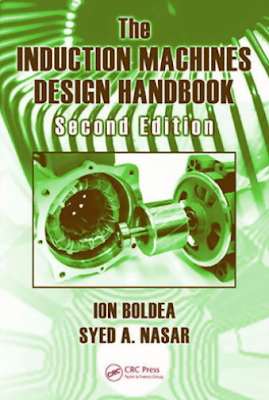Download The INDUCTION MACHINES DESIGN HANDBOOK SECOND EDITION Edit By ION BOLDEA SYED A. NASAR
Contents Mechanical Engineering:
1- INDUCTION MACHINES: AN INTRODUCTION
2- CONSTRUCTION ASPECTS AND OPERATION PRINCIPLES
3- MAGNETIC, ELECTRIC, AND INSULATION MATERIALS FOR IM
4- INDUCTION MACHINE WINDINGS AND THEIR MMFs
5- THE MAGNETIZATION CURVE AND INDUCTANCE
6- LEAKAGE INDUCTANCES AND RESISTANCES
7- STEADY-STATE EQUIVALENT CIRCUIT AND PERFORMANCE
8- STARTING AND SPEED CONTROL METHODS
9- SKIN AND ON–LOAD SATURATION EFFECTS
10- AIRGAP FIELD SPACE HARMONICS, PARASITIC TORQUES, RADIAL FORCES, AND NOISE
11- LOSSES IN INDUCTION MACHINES
12- THERMAL MODELING AND COOLING
13- INDUCTION MACHINE TRANSIENTS
14- MOTOR SPECIFICATIONS AND DESIGN PRINCIPLES
15- IM DESIGN BELOW 100KW AND CONSTANT V AND f (Size Your Own IM)
16- INDUCTION MOTOR DESIGN ABOVE 100KW AND CONSTANT V
17- INDUCTION MACHINE DESIGN FOR VARIABLE SPEED
18- OPTIMIZATION DESIGN
19- THREE PHASE INDUCTION GENERATORS
20- LINEAR INDUCTION MOTORS
21- SUPER-HIGH FREQUENCY MODELS AND BEHAVIOR OF IMs
22- TESTING OF THREE-PHASE IMs
23- SINGLE-PHASE INDUCTION MACHINES: THE BASICS
24- SINGLE-PHASE INDUCTION MOTORS: STEADY STATE
25- SINGLE-PHASE IM TRANSIENTS
26- SINGLE-PHASE INDUCTION GENERATORS
27- SINGLE-PHASE IM DESIGN
28- SINGLE-PHASE IM TESTING
Preface Mechanical Engineering:
The well-being of an environmentally conscious contemporary world is strongly dependent on its efficient production and use of electric energy. Electric energy is produced with synchronous generators, but for the flexible, distributed, power systems of the near future, the induction machine as an electric generator/motor at variable speeds is gaining more and more ground. Pump storage hydroelectric plants already use doubly-fed induction machines up to 300MW/unit with the power electronic converter on the rotor side.
On the other hand, the induction motor is the workhorse of industry due to its ruggedness, low cost, and good performance when fed from the standard a.c. power grid. The developments in power electronics and digital control have triggered the widespread usage of induction motor for variable speed drives in most industries. We can safely say that in the last decade the variable speed induction motor has already become the racehorse of industry.
While in constant speed applications better efficiency and lower costs are the main challenges, in variable speed drives, motion control response quickness, robustness, and precision for ever wider speed and power ranges are the newly added performance indexes. The recent development of super-high-speed variable drives for speeds up to 60,000 rpm and power in the tens of kW also pose extraordinary technological challenges. In terms of research and development, new analysis tools such as finite element field methods, design optimization methods, advanced nonlinear circuit models for transients, vector and direct torque control, and wide frequency spectrum operation with power electronics have been extensively used in connection with induction machines in the last 20 years.
There is a dynamic worldwide market for induction machines for constant and variable speed applications; however, an up-to-date comprehensive and coherent treatise in English, dedicated to the induction machine (three phase and single phase) embracing the wide variety of complex issues of analysis and synthesis (design), is virtually nonexistent as of this writing. The chapters on IMs in electric motor handbooks contain interesting information but lack coherency and completeness.


Post a Comment